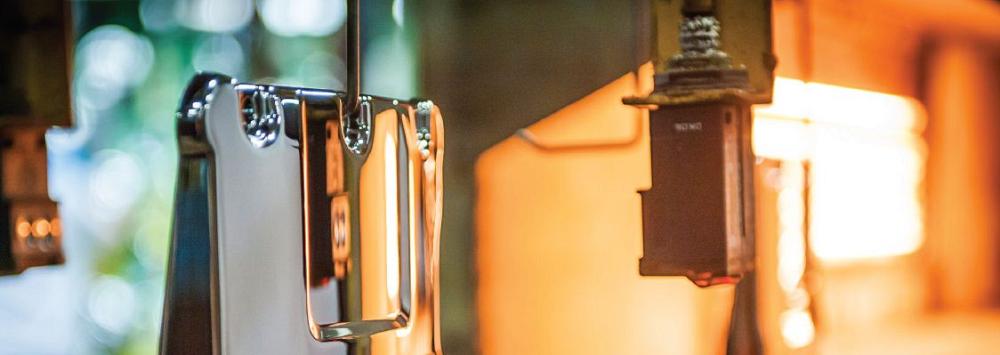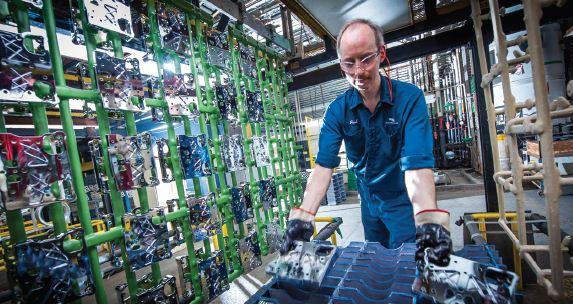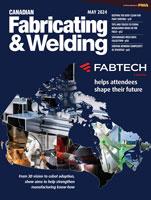Associate Editor
- FMA
- The Fabricator
- FABTECH
- Canadian Metalworking
A complementary process
Metal finishing brings machined pieces to completion
- By Lindsay Luminoso
- February 4, 2015
- Article
- Metal Finishing
The metal finishing industry is inextricably linked to the metalworking industry, as almost every metallic part must be finished in one way or another. The Canadian Association of Surface Finishing (CASF) represents the wide range of companies dedicated to various surface finishing processes, and although surface finishing is not specific to metal alone the association primarily deals with metal finishing, concentrating on electroplating, anodizing, and coating.
We spoke with Mike Kuntz, vice-chair of CASF and vice president of sales and marketing of Kuntz Electroplating Inc. (KEI), located in Kitchener, Ontario, to gain a better understanding of the depth and reach of the metal finishing industry in Canada.
CFW: How does the Canadian Association of Surface Finishing (CASF) function within the industry?
Kuntz: When it comes to the association, the CASF has been going on since the 1980s. It really is here to represent the surface finishing industry. The CASF used to be the Canadian Association of Metal Finishing and in the ‘90s that was changed to broaden the scope and open it up to finishing in general.
It still hasn’t broken out of its original mold, specifically metal finishing…I think there is a long term goal to include painting, which is a source of finishing. The primary mode of finishing, certainly on metal parts and equally on plastics, is the electroplating process.
Outside of metal finishing and electroplaters, you have the suppliers, and the professionals like environmental engineers and consultants, that are all involved. The chemical suppliers are a huge part of the industry and associations.
In the last three years there has been a revival to reach out and provide a resource to the industry because it still employs tens of thousands of people across the nation. [The CASF] launched a new website last year, and every year there are networking events, technical/environmental forums, and social networking events to bring people together to talk about the industry.
CFW: Why is metal finishing so important?
Kuntz: Without it, parts can fail prematurely and there are safety issues. A lot of finishing happens in the aerospace industry, for example. There is some very technical finishing that happens on landing gear, of say a [Boeing] 747 for example, that if you don’t do it your plane doesn’t land. Automotive, aerospace, and mining and gas exploration all have a fairly healthy finishing industry that support them. When you see Harley Davidson, for example, [the metal finishing] serves two purposes. It provides corrosion protection because you have parts that are exposed to the environment; it also has the aesthetic, jewelry-type look. That’s a traditional nickel plated part. It’s a huge industry in North America that accounts for somewhere between $500 million to $1 billion just for the decorative plating, and it’s not just metal parts that get finished but also plastics and composites.
The electronics industry is also quite large, like printed circuit boards, and it has a number of different surface finishing processes that apply. Specialty metals and copper are what let the electricity run through the components, and you are plating conductive metal on to non-conductive materials that allows current to run through them.
CFW: What are some of the challenges facing the surface finishing industry in Canada?
Kuntz: It’s a shrinking industry in Canada, but it’s an essential part of the industry. The surface finishing industry is faced with the same struggles and challenges as any other traditional manufacturing sector in Canada.
We are struggling just like anybody else with the high labour rates here. Our customers require us to be globally competitive. A lot of the finishing that used to happen in Canada or the U.S. has gone to China or Mexico.
The shops that are left are the ones that are specialized. What we would consider advanced manufacturing, where there are real technical/specific technologies required, or specific manufacturing processes that cannot be easily repeated somewhere else, especially in low-labour-cost countries. Those are the ones that are thriving.
It’s cyclical too, [Kuntz Electroplating is] an automotive company for the most part, and we kind of live and die by automotive volumes. Same goes with aerospace suppliers. They are experiencing a boom right now due to resurgence in aerospace manufacturing. But it’s cyclical; the ones that are doing well are the ones that specialize, or have embraced lean manufacturing, technology and automation, and focus on responsive, flexible supply chains.
CFW: How do environmental regulations affect the surface finish industry?
Kuntz: The regulatory environment is changing so quickly. We are probably one of the most heavily regulated industries in Canada, with a few minor exceptions. There are an extreme number of environmental regulations, from municipal, provincial and right up to the federal level, and for good reason. It’s a chemical intensive process and industry; you can’t afford to have a mistake. That doesn’t change the fact that it becomes a heavy burden to make sure that you are in line with all the different changing regulations.
[At Kuntz Electroplating], we have 15 full time environmental people at our company that take care of the entire sustainability program, all of our waste streams, recycling, energy, water, and air. We are proud of that, and we are always trying to stay ahead of the curve with environmental technology.
It’s still a cost burden; it’s part of the cost of doing business in this industry.
CFW: Is there a specific region in Canada that you see a concentration of metal finishing companies?
Kuntz: The majority of finishers reside in Ontario and Quebec. There is a fairly healthy finishing industry in the West as well that is associated with the oil and gas and mining industry. Those are functional type finishers, very specialized. You’ve got very large mining equipment and oil and gas services require specialized equipment under very harsh conditions, so there are some very large, healthy finishers that are again specialized for servicing a specific industry and sticking close to that industry. For the short responsive supply chains, they are important to compete today.
CFW: We are seeing a trend in other industries where OEMs are in-sourcing or moving ancillary processes in-house, is this the case for surface finishing?
Kuntz: The trend is actually the opposite in the finishing industry. It is such a specialized function of the manufacturing process. A lot of the OEMs are saying “this isn’t our core competency, so why are we doing it.” The finishing business is a high fixed-cost business, there are barriers to entry, and there are extreme environmental requirements and restrictions. There are a lot of heavy chemicals used and it requires a lot of due diligence to make sure those are managed properly.
The big OEMs are outsourcing more. Harley Davidson is a good example of that. They were huge into doing electroplating, the decorative nickel-chrome plating, that bling that you see on their motorcycles. They did a lot of that in-house. Five to six years ago they made the conscious decision that they couldn’t compete anymore. They now outsource all of their electroplating needs. Some painting is done in house, but the more specialized electroplating they decided to outsource, and that is a fairly common trend we are seeing which presents opportunity for those that are competitive in that space.
There is certainly a lot of consolidation though. The last recession took a big bite out of the industry. A lot of the smaller, less competitive finishers in the industry just couldn’t compete. They were already sort of hanging on and if they didn’t commit to lean processes and right sizing their business, they weren’t able to survive the storm.
CFW: Is it common for a surface finishing company to specialize in only one type of process?
Kuntz: It’s kind of split. There are many finishers that offer a broad range of finishing services. There is hard chrome plating, anodizing, and dozens of electroplating finishes that you can provide. It depends on how specialized each company wants to become.
For example, [KEI] used to provide dozens of different kinds of finishes. Then we saw there was an opportunity in high-volume decorative nickel chrome on metal substrates like steel and aluminum. We decided to specialize and carve out our niche. That was a good decision, as there weren’t and still aren’t many companies today that can provide the level of cosmetic quality and functional quality at the same time at the volumes that the motorcycle and automotive industries require.
There are others that are more diversified though. In some other spaces, like functional finishes, it is a little more competitive and commoditized. Like when you are doing fasteners for example, you are doing millions, and hundreds of millions of nuts and bolts per year.
It’s a mixture really.
CFW: Any final thoughts?
Kuntz: The metalworking and metal surface finishing industries are complementary to each other. Many of the parts that are surface finished have to be metal worked first, they need to be machined and have exact tolerances built into them. What’s interesting is a lot of times the finishing needs to be factored into the metalworking, because with finishing you are building up surfaces. So if you don’t take into consideration a couple of thousandths of metal thickness building up on a metal finished part, then things just don’t fit.
Many of the metalworkers who work with metal finishers understand through the OEM designs that these tunings need to work together. Many of the metal finishers will work closely with the machine shops to make sure that the quality is in sync and unison.
About the Author

Lindsay Luminoso
1154 Warden Avenue
Toronto, M1R 0A1 Canada
Lindsay Luminoso, associate editor, contributes to both Canadian Metalworking and Canadian Fabricating & Welding. She worked as an associate editor/web editor, at Canadian Metalworking from 2014-2016 and was most recently an associate editor at Design Engineering.
Luminoso has a bachelor of arts from Carleton University, a bachelor of education from Ottawa University, and a graduate certificate in book, magazine, and digital publishing from Centennial College.
subscribe now


Keep up to date with the latest news, events, and technology for all things metal from our pair of monthly magazines written specifically for Canadian manufacturers!
Start Your Free Subscription- Industry Events
Automate 2024
- May 6 - 9, 2024
- Chicago, IL
ANCA Open House
- May 7 - 8, 2024
- Wixom, MI
17th annual Joint Open House
- May 8 - 9, 2024
- Oakville and Mississauga, ON Canada
MME Saskatoon
- May 28, 2024
- Saskatoon, SK Canada
CME's Health & Safety Symposium for Manufacturers
- May 29, 2024
- Mississauga, ON Canada























